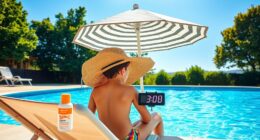To create your own DIY tanning accelerators, use natural oils like fractionated coconut, olive, or avocado for hydration and antioxidants. Add coffee grounds or essential oils like lavender or cedarwood to boost melanin production and enhance tanning. Be sure to perform patch tests and follow safety precautions to avoid irritation. Using proper equipment and storing your blend in dark bottles guarantees quality. Keep exploring further to discover more tips for a safe, effective glow.
Key Takeaways
- Use natural ingredients like tyrosine and coffee grounds to stimulate melanin production and enhance tanning.
- Incorporate carrier oils such as fractionated coconut or MCT oil for quick absorption and skin hydration.
- Add antioxidant-rich oils like roasted coffee oil and vitamin E to protect skin and support tan longevity.
- Include essential oils like lavender or carrot seed for fragrance and skin nourishment.
- Store your DIY tanning accelerator in dark glass bottles and perform patch tests before use.
Understanding the Benefits of Natural Ingredients
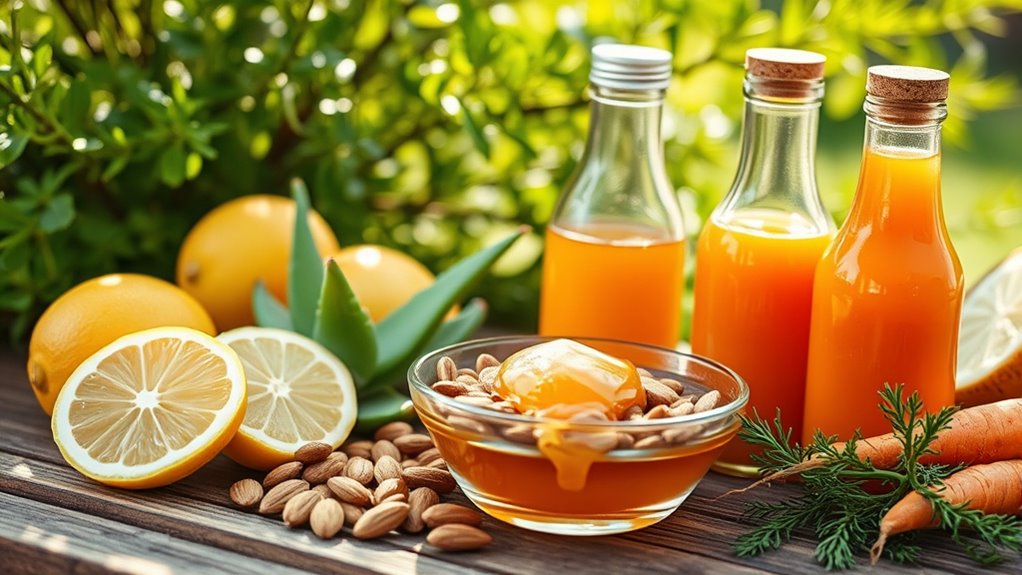
Natural ingredients play an essential role in enhancing your tanning experience by offering numerous benefits. They boost melanin production, helping you tan faster and more evenly. Ingredients like tyrosine stimulate your melanocytes, speeding up the process naturally. Hydration is key, and natural moisturizers such as aloe vera and coconut oil keep your skin hydrated, improving tanning results. Aloe vera not only moisturizes but also protects your skin from irritation and UV damage. Using these ingredients supports healthy skin, reduces irritation, and promotes a longer-lasting tan. Understanding the process of melanin production can help you make better choices for your tanning routine. Incorporating natural, nourishing ingredients into your routine ensures you enjoy a safer, more effective, and nourishing experience, giving you a beautiful, even glow with less risk of skin damage. To maximize their benefits, consider how skin absorption of natural ingredients enhances their effectiveness in your tanning regimen. Additionally, choosing products with high-quality natural extracts can further improve results and skin health.
Crafting Your Own Tanning Oil at Home
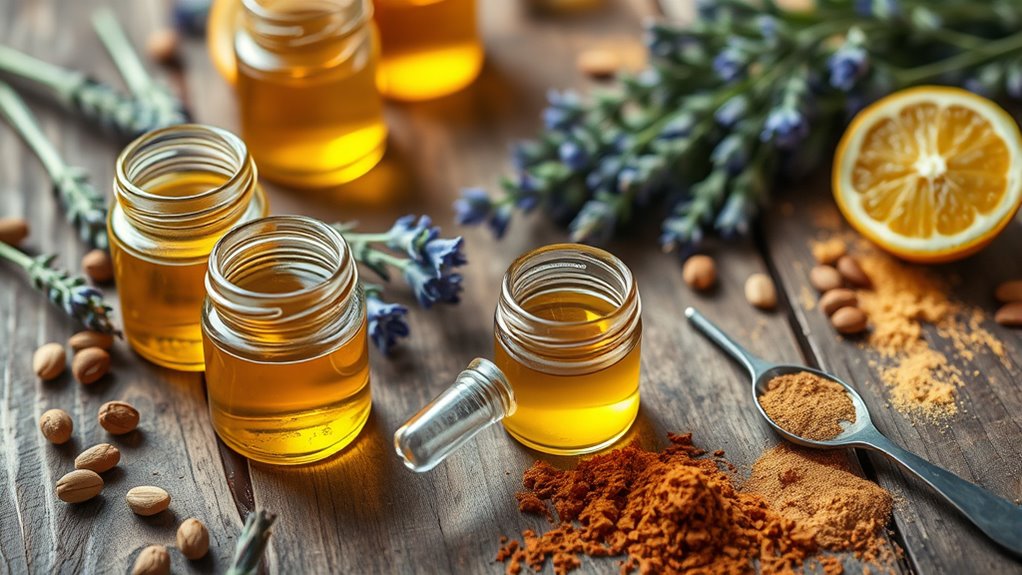
Creating your own tanning oil at home allows you to customize ingredients to suit your skin type and preferences, guaranteeing a safer and more effective experience. Start with a light carrier oil like fractionated coconut or MCT oil, which absorbs quickly and hydrates. Add nourishing oils such as olive or avocado oil for antioxidants and skin hydration. Incorporate coffee essential oil or grounds to boost antioxidants and provide a slight tanning effect. Enhance fragrance and skin benefits with essential oils like lavender, cedarwood, or carrot seed. Include vitamin E or vitamin C for antioxidant support and skin health. Use precise measurements with a scale and store your blend in dark glass bottles to preserve potency. Mix thoroughly to ensure even distribution, then apply before sun exposure for ideal results.
Safe Use of Tan Accelerators and Precautions
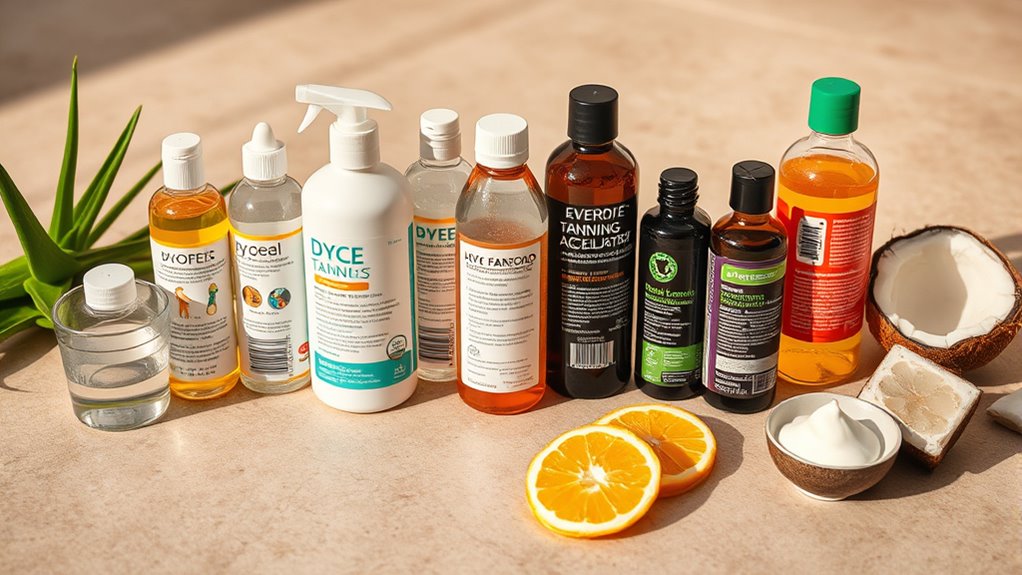
To guarantee safe and effective use of tanning accelerators, it’s essential to follow proper guidelines and precautions. Always perform a patch test on a small skin area before initial use to spot potential allergies or reactions. If you notice redness, itching, or irritation, stop using the product immediately. Use only products with clear ingredient lists, and avoid applying them on broken, sensitive, or inflamed skin. Follow the manufacturer’s instructions carefully regarding application and duration. Don’t overapply or leave products on longer than recommended. During sun exposure, start with short sessions, gradually increasing exposure time while wearing protective clothing on non-target areas. Keep products out of reach of children, wash hands after application, and avoid eye contact to prevent irritation. It is also helpful to incorporate proper skin preparation like exfoliating before application to ensure even tanning. Additionally, choosing products with appropriate glycolic acid concentrations can enhance exfoliation, leading to a more uniform and effective tan. Incorporating mindfulness techniques, such as deep breathing or visualization, can help you stay relaxed and focused during application and sun exposure. Ensuring fraud prevention tools are in place when purchasing online can help verify product authenticity and safety. Furthermore, selecting products with transparent privacy policies ensures your personal information remains protected during online transactions.
Essential Equipment for DIY Tanning Products

Having the right equipment is essential for accurately mixing and storing your DIY tanning products. Use glass lab beakers for precise measurement and blending of oils and actives, ensuring consistent formulations. Store finished products in dark-colored glass bottles to protect contents from light degradation, maintaining potency. Pump bottles are perfect for dispensing lighter carrier oils like fractionated coconut oil, making application easier and reducing contamination. Small containers and pipettes help measure tiny amounts of active ingredients such as vitamin E, vitamin C, and vitamin D, ensuring accuracy. Use whisks or mixing sticks to thoroughly combine ingredients for a uniform product. Additionally, a precise cosmetic scale and proper labeling materials are key for consistent batches and quality control. Proper storage in cool, dark places extends shelf life and preserves effectiveness. Incorporating automation into your process can also streamline production and improve consistency, which aligns with modern creative techniques for DIY skincare. Implementing quality control measures ensures each batch meets safety and efficacy standards, safeguarding your skin and investment. Maintaining uniform mixing is crucial for achieving reliable results, especially when working with potent active ingredients. Using high-quality storage containers helps prevent contamination and degradation over time.
Staying Informed on Trends and Ingredient Choices
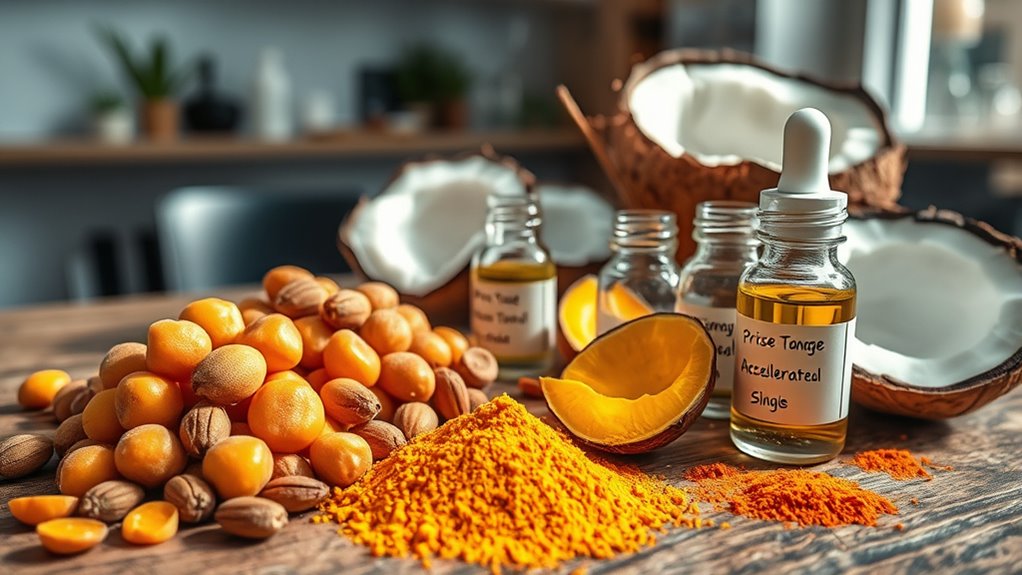
Are you staying current with the latest trends and ingredient choices in DIY tanning accelerators? Keeping up means focusing on natural, plant-based oils like fractionated coconut oil, which moisturize without feeling greasy. Incorporate antioxidant-rich ingredients such as roasted coffee oil and vitamin E to protect your skin from sun damage while boosting tanning effects. Vitamins like C and D support melanin production and collagen health, enhancing your tan and skin elasticity. Avoid synthetic fragrances, mineral oils, and chemical filters to reduce irritation and aging. Popular trends include using coffee grounds or infused oils for instant color and antioxidant benefits. Also, combining moisturizing oils with tanning accelerators and staying aware of emerging research helps you craft safe, effective formulas aligned with consumer demands for transparency and natural ingredients. Additionally, understanding the best anime movies can provide inspiration for creative and relaxing self-care routines. Being informed about industry voiceover trends can help you better understand how to market your products effectively and connect with your audience. Staying aware of safety standards such as proper handling and storage of ingredients ensures your DIY formulations are both effective and safe. Furthermore, staying informed about influencer marketing strategies can help you reach a broader audience interested in natural skincare solutions.
Frequently Asked Questions
Can DIY Tanning Accelerators Cause Skin Allergies or Sensitivities?
Yes, DIY tanning accelerators can cause skin allergies or sensitivities. You might experience redness, itching, or rashes if ingredients like lanolin or certain carrier oils irritate your skin. To reduce risks, always perform a patch test before full application and choose natural, hypoallergenic ingredients. Avoid synthetic fragrances and harsh chemicals, and if you notice any reactions, stop use immediately and consider switching to gentler alternatives.
How Long Does a Homemade Tanning Oil Typically Last Before Needing Replacement?
Ever wonder how long your homemade tanning oil stays effective? Usually, it lasts about a year if stored properly in a cool, dark place. Once opened, it may spoil sooner, especially if natural ingredients are involved. To keep it fresh, check for changes in smell, color, or texture. Don’t forget—using it within the recommended time ensures safety and best results. How often do you inspect your skincare products?
Are There Any Age Restrictions or Safety Concerns for Minors Using DIY Tanning Products?
You should know that minors generally don’t have specific age restrictions for DIY tanning products, but safety is a major concern. Their skin is more sensitive and prone to damage, so supervision and proper education are essential. It’s best to explore safer options like spray tans or natural oils, and always follow safety guidelines. Encourage minors to prioritize skin health and avoid risky UV exposure for long-term benefits.
What Are the Best Storage Conditions to Preserve DIY Tanning Ingredients?
Oh, so you want to keep your DIY tanning ingredients fresh? Surprisingly, the best storage conditions are simple: keep them in a cool, dark place away from heat, light, and humidity. Use airtight, opaque containers, store upright, and avoid bathrooms or cars where temperature swings happen. This way, your ingredients stay effective longer, preventing spoilage and ensuring your tan turns out flawless—no surprises, just perfect results.
Can DIY Tanning Recipes Be Customized for Different Skin Tones or Types?
You can customize DIY tanning recipes for different skin tones and types easily. For fair skin, opt for lighter ingredients like black tea for a natural glow. Medium skin benefits from cocoa powder, while dark skin can handle coffee oil for depth. Sensitive skin should use natural, gentle ingredients like coconut oil, and dry skin needs moisturizing additives like lanolin. Adjust ingredient amounts to achieve your desired tan intensity and verify skin compatibility.
Conclusion
By creating your own tanning accelerators, you hold the brush to paint your perfect glow with natural ingredients. Think of it as tending a garden—nurturing your skin gently while avoiding harsh chemicals. With the right tools, safety tips, and a dash of creativity, you can achieve a radiant tan that’s truly your own masterpiece. Embrace this DIY journey, and let your sun-kissed glow bloom naturally, like a flower reaching for the warm sunlight.







